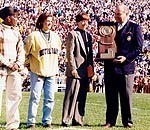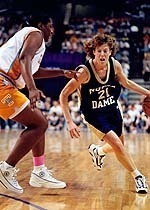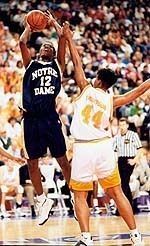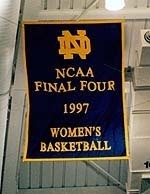Sept. 28, 2006
By Ken Kleppel
In the Queen City of Cincinnati, the twentieth installment of the women’s basketball program became affectionately known as Cinderella for its remarkable run into the Final Four as the East Region’s sixth seed in the 1997 NCAA Tournament.
The players’ glass slippers were basketball shoes; their ballroom dresses were sleeveless jerseys. But, in true rags-to-riches lore, their ascension to the game’s biggest ball was anything but a right of inheritance.

Head coach Muffet McGraw and members of the 1997 Final Four team present the trophy to then-athletics director Mike Wadsworth during a 1998 football game at Notre Dame Stadium.
|
“For all of us on that team, hard work was our motto,” says then-junior guard and captain Mollie (Peirick) Peirick-Busam. “We were not even picked to play past the first round, but we became a success because of our work ethic. We were underdogs and some discounted our abilities, but we worked our tails off to prove others wrong.”
And over the course of an amazing thirty-eight game stretch from November 1996 to March 1997, an active roster that at one point dwindled down to just seven players–but never one that was short on dedication and perseverance–somehow managed to create the legacy for women’s basketball at Notre Dame.
“When you are the first to do something, you set the bar a bit higher and give confidence for others to do the same,” says head coach Muffet McGraw. “That team started the tradition here.”
Just four years later, the program worked its way back to the Final Four and earned its first national championship. Since March 1997, McGraw-led teams have made nine consecutive NCAA Tournament appearances, advanced to the round of sixteen on six occasions, and failed to compete in the second round of the Tournament only once.
But this team, clad in green-painted fingernails, was special. Earning its first 35-win season and best record in program history, Notre Dame was ranked in the top twenty-five of both the ESPN/USA Today and Associated Press polls from start to finish. The program also achieved all-time high ranking in both final polls by finishing fifth in the ESPN/USA Today rankings and 15th in the Associated Press poll. In March, Notre Dame beat the higher-ranked team in three straight Tournament games to become the second-lowest seed in Tournament history, and just the third seeded below four, to advance to the Final Four. And they accomplished all this with an active roster of only seven for the most significant stretch of the season. Everyone contributed–even the senior student manager. In the semi-finals of the BIG EAST Tournament, McGraw suited up student manager Christy Grady to provide depth for the remainder of tournament play.

A two-year captain, Beth (Morgan) Cunningham, was a two-time all-BIG EAST and Associated Press All-American. She set or tied 28 school records during her Notre Dame career and is still the all-time leading scorer for the Irish with 2,322 points.
|
“We were a very special team,” says then-senior guard, captain, and All-American Beth (Morgan) Cunningham. “For the group of us that came in as freshmen, it was our goal to take the program to new elite status and make it a top program. We were able to build every year and four years of hard work culminated in a chance to play in the Final Four. Outside of winning the national championship, I cannot think of any better way to end our senior year.”
By all accounts, the Class of 1997 accomplished its goal. The senior class won at least 20 games in each of its four seasons, and appeared in three consecutive NCAA Tournaments in transitioning the program from Midwestern Collegiate Conference play to the BIG EAST and ultimately to un-chartered territory in March.
And leading the charge were seniors Cunningham and Katryna Gaither, the program’s all-time leading career and single-season scorers.
The Combination of Inside-Outside Duo
Cunningham was the outside shooter–the daughter of former Indiana University head baseball coach Bob Morgan and a heavily recruited Midwesterner. Katryna Gaither was the interior player–the daughter of a real estate broker and a lightly recruited and lanky New Yorker. But while their backgrounds and styles were markedly different, together they made the perfect pair on the court. Cunningham and Gaither graduated as and remain the most prolific scorers in program history and were the first two to be named to the Associated Press and United Press International honorable mention All-America teams.
“We really complemented each other so well,” says Cunningham. “She dominated the inside, had great athleticism and a knack for scoring, and was a great rebounder and a fierce competitor. If a team could stop one of us, it would not be able to stop the other.”
Cunningham set or tied 28 school records during her tenure at Notre Dame, including career scoring (2,322), and captained the team as a junior and senior. She was first-team all-BIG EAST and an Associated Press All-American in her final two seasons.
“Beth is the best leader I have ever coached,” says McGraw. “She is an amazing player. She was a vocal leader and set the tone for the team. She made sure that adversity did not prevent us from advancing. I really think that she willed us to victory.”
Cunningham’s effectiveness on the outside was facilitated by Gaither’s presence on the inside.
“If it was not for Coach McGraw’s toughness and fierceness, I would not have been where I was at my senior year,” says Gaither. “Each off-season I trained hard and worked to put muscle on my body. That was the way that I could show the team how much I wanted it.”

Katryna Gaither was the MVP of the East Region in Notre Dame’s 1997 trip to the NCAA Final Four. She teamed with Beth Morgan to give the Irish a hard-to-stop one-two punch throughout their careers. Gaither is the program’s second-leading scorer (2,126) and third-leading rebounder (986).
|
The record books provide proof of this maturation process. Gaither finished as the program’s second all-time leading scorer (2,126) and third all-time leading rebounder (986). Her 776 points during her senior season is a Notre Dame record, with Cunningham’s 696 as the program’s second-best.
“I don’t think there was a ball she could not catch,” says Peirick-Busam. “The way she ran the floor as the center, it was so much fun to play with her and run breaks. She was a great worker.”
Although Cunningham and Gaither dominated the box score and the stat sheets, the supporting cast may have made the biggest difference.
Overcoming Adversity and Coming Together
From the first day of practice until the quarterfinals of the BIG EAST Tournament, injuries decimated Coach McGraw’s rotation.
Twenty minutes into the first practice, sophomore guard Danielle Green tore an Achilles tendon and was lost for the season. In the fifth game, freshman guard Niele Ivey’s knee ligament ripped and she was red-shirted as well.
Needing help, McGraw invited volleyball player Kristina Ervin to join the team, but a broken nose sidelined her after six games. In February, junior guard Kari (Hutchinson) Miller fractured her right hand in practice and missed eight games. And in the quarterfinals of the BIG EAST Tournament, senior guard Adrienne Jordan was sidelined for the rest of the season with a fractured right hip.
But the team came together as the supporting cast to the Cunningham-Gaither main act played their roles to perfection.
Senior point guard Jeannine (Augustin) Scheffler led the team in steals and bruises as its defensive specialist and one of three captains.
Senior guard Adrienne Jordan advanced from walk-on to significant contributor, and was named to the Big East Academic All-Star team that season.
Senior power forward Roseanne Bohman was the team’s most powerful player, but used her shooting touch to connect on all eight of her field goals against Texas to help Notre Dame advance to its first Sweet Sixteen. Senior student manager Christy Grady moonlighted as a reserve forward and gained national notoriety, including recognition as the CNN Play of the Day, for her basket against Georgetown in the BIG EAST Tournament semifinal.
Peirick-Busam, played in all 38 games, averaging nearly eight points and more than four assists per contest, while leading the team as a captain in just her third season.
Miller returned from a broken right hand just in time for the NCAA Tournament opener against Memphis and provided desperately needed contributions off the bench.
Sophomore guard Sheila McMillan (Keller) was the sharpshooter, connecting on clutch three-point field goals throughout the season in eventually earning her own place in the record books by the end of her four-year career.

The Irish battle Tennessee at Cincinnati’s Riverfront Coliseum in their first-ever NCAA appearance in 1997.
|
Freshman center Julie Henderson served admirably as a reserve forward, playing in all 38 games and providing depth at her position. Green would provide leadership for the program for the next three seasons, totaling 65 career starts over her Notre Dame career. Likewise, Ivey would lead the Irish to the 2001 National Championship as its All-American point guard in her senior year.
“This was the smartest team that I have ever coached,” says McGraw. “They were unselfish. There was no jealousy among the players but just great chemistry.”
The NCAA Tournament provided the perfect showcase for this great team play.

Notre Dame’s 1997 Final Four banner hands proudly above the court at the Joyce Center.
|
A March to Remember
Notre Dame entered the Tournament ranked fifteenth in the country, following a 27-6 regular season, with two of those losses coming to top-ranked Connecticut and another to second-ranked Tennessee, and a second-place BIG EAST finish.
But instead of the selection committee rewarding Notre Dame as a host site, tournament-play instead took the squad to the East Region with the opening games in Austin, Texas.
In their first-round win over eleventh-seeded Memphis, Gaither scored 24 points, including career-point number 2,000, and grabbed 12 rebounds to help the Irish cruise to a 31-point victory. Two days later, in an upset fitting of St. Patrick’s Day, the Irish shocked host-school and third-seeded Texas, 86-83, with Cunningham and Gaither scoring 29 points each. Notre Dame traveled to Columbia, South Carolina, and erased a nine-point second half deficit to defeat second-seeded and seventh-ranked Alabama, 87-81, behind Morgan’s career-best total of 36 points and Gaither’s 26. The Irish sealed their opponent’s fate with a game-deciding 33-5 run that started with 22-straight points during a six-minute stretch in the second half.
In the regional final against fourth-seeded George Washington, Gaither led all scorers and rebounders with 26 and 16, respectively, to spark Notre Dame to a 62-52 victory. With that win, Coach McGraw had her 300th career victory, Gaither was named MVP of the East Region, and Notre Dame was on its way to its first Final Four.
The dream would end with a hard-fought 80-66 loss to eventual champion Tennessee in the national semifinals.
One Final Curtain Call
A decade later, the return trip to campus in celebration of a 10-year anniversary of the Final Four team is markedly different than the first. Wide-eyed college innocence has been supplanted by a lifetime worth of experiences.
Now in their late twenties to early thirties, the women have become mothers and coaches, professional athletes and executive administrators and even an inspirational war veteran.
“After ten years, I can honestly say that Notre Dame has contributed greatly to my success,” says Gaither. “Just to be a part of the history here is special. There are always so many great things going. I am proud that we were the start of something good.”
The legacy continues today, on and off the court. Midnight has long since struck, but the glass slipper still fits.






